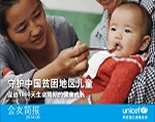Imagine an electronic birth certificate is allocated to all newborns in China as part of a web-based information management system covering the whole country. Health workers can instantly access the maternal and child care service data, immunization records information and other public health interventions of a child through a computer, laptop, tablet or mobile phone from anywhere, just by typing a unique numerical code assigned to the child upon her/his birth. Moreover, the system will enable vital historical data to “travel” with children who migrate with their parents.
That vision may become reality in a few years' time, as the enormous fragmentation facing China's health information system is being addressed to improve the survival, growth and development of children.
Currently, one third of China's children, in particular the youngest and most vulnerable, failed to receive a birth certificate within days of their birth, which is a prerequisite for welfare entitlements and enrollment in China's health insurance system, thus are at risk of exclusion from essential health services and other entitlements. The divide between the clinical and preventive segments of the country's health care system also enables missed opportunities for delivering a needed vaccination, which can be complicit in disease outbreaks, such as polio and measles.
Capturing and storing information electronically on every newborn in China will provide critical information to the government agencies for evidence informed policy setting and decision making. Since 2011, medical facilities in six prefectures have been using the system, which replaces paper-based processes, with more facilities switching through the recently kicked off second phase of a partnership involving Hewlett-Packard, the Government of China and UNICEF.
The system combines UNICEF and the National Health and Family Planning Commission's expertise on maternal and child health as well as IT expertise from HP. Although still a work in progress, HP is helping expand the programme's reach by developing a cloud-computing solution to support the system, creating the platform for mobile applications and building a national laboratory for testing, data storage and for training.
It will also contribute to the Government's ambitious vision to develop a single, integrated health information system, known as “4-6-3-1-2” plan[1].
In the second phase, project areas will be expanded from the existing sites to include Foshan in Guangdong Province, where there is a high number of migrants, and to more current UNICEF integrated MCH project sites.
A total of 336,000 pregnant women and a similar number of children younger than five years of age are estimated to become direct beneficiaries of the project. With an estimated 25 preventive and/or curative visits for each child and 15 care seeking events for every pregnant woman over a three-year period, more than 13 million of improved health worker encounters will be conducted in project areas during the project period.
“We believe it can make a valuable contribution to the goal of further building a strong primary health care system that covers the world's most populous country and benefits children in the remotest and poorest regions as well as those migrated to urban areas,” said Gillian Mellsop, UNICEF Representative to China.
Due to the successful experiences in the UNICEF-HP pilot areas, Shijiazhuang in Hebei Province and Liuzhou in Guangxi Zhuang Autonomous Region requested to join the project at their own expenses. Other governments and public welfare organizations are now encouraged to do the same.
By Yang Jingjie
[1]About‘4-6-3-1-2' plan: 4 means four information platforms at national, province, prefecture, and county level; 6 means six health information sub-system, public health, medical service and management, new rural health cooperation scheme, national basic drug monitoring, comprehensive health management, and family planning; 3 means three basic health database individual health record, electronic patient record, and population information; 1 means one national health network; 2 means two supporting and security system development, national health information standard and information security.




























